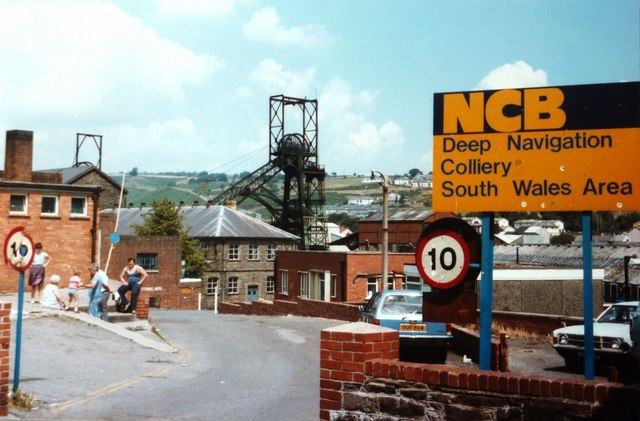Deep Navigation Colliery, Treharris, South Wales
Introduction
The photograph on this page of Deep Navigation Colliery, Treharris, South Wales by Tom Jolliffe as part of the Geograph project.
The Geograph project started in 2005 with the aim of publishing, organising and preserving representative images for every square kilometre of Great Britain, Ireland and the Isle of Man.
There are currently over 7.5m images from over 14,400 individuals and you can help contribute to the project by visiting https://www.geograph.org.uk

Image: © Tom Jolliffe Taken: Unknown
This was, I think, the main entrance to Deep Navigation Colliery in Treharris. At the time this picture was taken, the pit was idle during the prolonged industrial dispute. Many individuals and groups tried to support the local community during the dispute with donations of food and necessities, etc. Looking back, there can be few who do not see the ending of coal production at the pit as anything but a disaster for the whole community. The pit has now disappeared, and new streets and some housing have been built in its place http://maps.google.co.uk/maps?f=q&source=s_q&hl=en&geocode=&q=trelewis&sll=53.800651,-4.064941&sspn=12.270158,27.070313&ie=UTF8&hq=&hnear=Trelewis,+Treharris,+Mid+Glamorgan,+United+Kingdom&ll=51.666134,-3.302443&spn=0.003168,0.006609&t=h&z=17&layer=c&cbll=51.666067,-3.30257&panoid=fgZvEoaoAbNEfpnj_EPBaw&cbp=12,231.77,,0,5 . See Image] and Image] and Image] for Chris Allen's pictures of the colliery as it was. "Deep Navigation Colliery was situated near Treharris in the Taff Bargoed Valley. In 1878 two shafts were sunk at the site which were, at the time, the deepest pits in the south Wales coalfield. During this period the mine was called Harris' Navigation Colliery after the name of the principal shareholder, F.W. Harris. The same man also gave his name to the neighbouring village of Treharris. In 1893, the Colliery was purchased by the Ocean Coal Co. Ltd. who changed its name to Deep Navigation Colliery. The Colliery produced high quality steam coal which was greatly in demand notably by Cunard Steamlines. Deep Navigation became the sole source of the coal used for the record-breaking trans-Atlantic crossings of both the SS Mauretania and the SS Lusitania. Another important event was the construction of the first ever pit head baths in the south Wales coalfield in 1916. Upon Nationalisation in 1947, the Colliery was placed into the National Coal Boards South Western Division No. 4 (Aberdare) Area, Group No. 4. Deep Navigation was the subject of heavy investment and reorganisation during the 1960s but remained in production until March 1991." Source: Ray Lawrence, The South Wales Coalfield Directory, Vol. 2 (1998 edn), p. 191 See http://www.archiveswales.org.uk/anw/get_collection.php?inst_id=35&coll_id=11590&expand=&L=1

